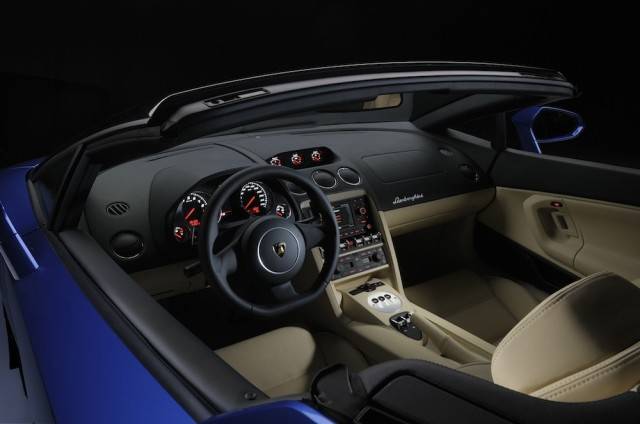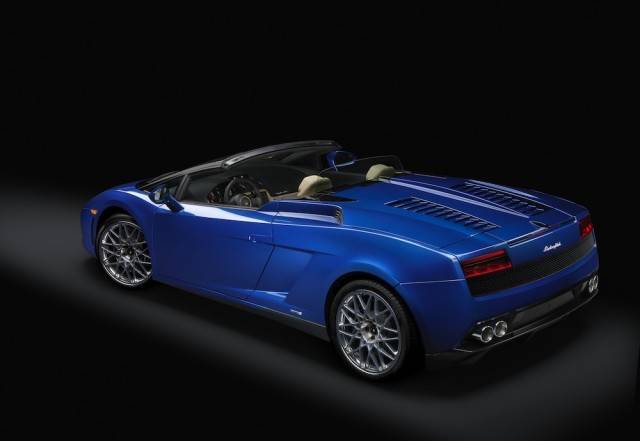Haute Auto of the Week: Lamborghini Gallardo, Commando Lambo
What is it about Lamborghinis? They thrill the senses, what with their angular masculinity and their amazing song. They certainly don’t look like anything else on the road. How do that do that, year after year, making such fresh statements?
The Gallardo (the “entry-level Lambo”) is a really interesting car. Named after a famous breed of fighting bulls (and pronounced “guy-yardo”), it’s a daily driver — which says a lot about a supercar — one equally at home in stop-and-go traffic and at the track. It can idle in congestion then blast into the straights and whip through the esses without a stumble or a whimper. It wasn’t that long ago when one had to choose – docile street sled or track tuner – but the Gallardo excels in all environments.
The Gallardo comes in two basic flavors, convertible and coupe, with additional variants – two- or all-wheel drive plus a super-light and a competition version or two – for a total of six choices. “Mine” was a black roadster (technically, an “LP 550-2 Spyder”, meaning it had 550HP and was a rear-wheel-drive car, not the “-4” all-wheel version), sinister and dark yet shiny and sharp-cornered. Something wicked this way comes. The red diamond stitching on the black leather sets said “elegance” yet the snarling exhaust (especially in track mode – more on that later) threatened to eat the young who were within earshot. My Monroney (window sticker) was $238,000 and a bit as it had heated seats, special badging and some other trick doodads. One also can utilize the new Lamborghini lease program, where the LP 550-2 Spyder can be leased for $2,289 per month for 36 months with $22k and change due at signing (price depends on options and is plus T&L, etc. but no security deposit required).
Some purists prefer the flingability of the rear-wheel-drive LP 550-2 – those of us who have spent a lifetime perfecting the heel-toe and double-clutch downshift, for example. More recent entrants to Earth find that quaint, asking if we also prefer the starter crank to today’s push-button vroomer. I really enjoyed controlled powerslides with massive intentional oversteer, calling forth all of the experience of my youth, but then I remembered the Assumption of Risk, Waiver of Liability and Release and Indemnity Agreement — at least it wasn’t governed by Italian law, as the Aventador’s rights-removal document was in my February adventure — and I returned to the real world.
As with some other supercars, there’s an easy way to dial a ride. Choosing between standard and CORSA (as in “race track”), for example, adjusts everything from the engine to the suspension (more drift angle permitted by the stability control system) to the exhaust note (the aural pleasures alone are worth twice the price of admission). I’d like the shake the hand of the engineer who invented the adjustable exhaust note as the sound of this car adds immeasurably to the joy of driving it.
All of the current Gallardos have the same motivator, a V-10 with enough torque to remove that dead tree you’ve been wanting to dispose of (technically, that’s just under 400 pound-feet). Is that a lot? Well, it can move this 3,351-pound car to 62 MPH in just over four seconds, sprinting on to 124MPH in the quarter-mile in the time that it took you to read this sentence (assuming that your eyeballs can move in 13.4 seconds). Top speed is 198MPH because, well, 200MPH apparently is just too much.
While all this technical stuff is well and good, what does it mean? Well, it means that you will have this Italianate orchestra behind you providing symphonic combustion sounds wherever you go. Coupled with the six-speed, double-clutch e-transmission, the paddle shifters can be wielded like a conductor’s baton and the go pedal can summon all of the ponies pronto, calling forth spectacular sounds on cue.
A welcome surprise was the seamless operation of the fabric convertible top. At the touch of a button, the rear deck lid pops up slightly then slides back before hinging from the rear, with the top then folding neatly into its bay before the rear lid returns to seal the deal. Transformers: More than meets the eye! The whole maneuver can be accomplished at a stoplight, much to the delight of the kids in the minivan behind you (more than once accompanied by ooohs from the soccer mom at the wheel).
Lamborghinis come in a wide range of hues, some no doubt inspired by Ken Kesey and his psychedelic friends. Mine was black on black on black so it looked like the perfect ride for Darth Vadar’s high-school reunion. It truly was stunning to behold, especially with the red stitching on the black leather seats and door panels and the red brakes offset against the shiny black rims.
Lamborghinis have come a long way in their fifty years on the planet. They’ve always been exotic but the Lambos of late are so amazingly user-friendly that I almost am tempted to say that they’re practical (almost). I used the car for my daily commute (I had the fastest car stuck in traffic) and for errands (it sure turns lots of heads in the Costco lot as well as on Rodeo Drive but falls somewhat short on the “how many grocery bags will it hold” meter). It looks, sounds and feels like nothing else and yet it’s easy and really fun to drive.
Many times I am asked by readers, “Would you buy this car?” In the case of the Lamborghini Gallardo Spyder, the answer is “assolutamente!”
Postscript: After the test drive and after this article was written, Lamborghini announced the end of the Gallardo run. After ten successful years, Lamborghini decided to retire this model, the “most-sold” of any of their cars ever (over 14,000 units). In Lamborghini’s first four decades, an average of just 250 Lamborghinis were built per year but, in the decade of the Gallardo, the company’s production grew to a whole new dimension, producing a yearly average of about 2,000 cars. The Gallardo was sold in more than 45 countries around the world. While we wonder what’s next, let’s pause for a Requiem for a Heavyweight.















